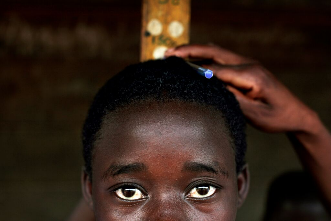Another year, another round of launches for the Global Nutrition Report. Why do we do it? Is it some suppressed desire
to be doing a world tour with a band? An
attempt to rack up air miles? Supporting
a double life as a hotel inspector?
No, it just seems the best way to communicate the gravity
and nuance of the malnutrition situation in a given context and to give added
impetus to those who are trying to find solutions.
Showing up equals engagement. And engagement is essential because the IEG
wants the report to be an intervention.
Last year the most media attention and the greatest impact
of the report was around the launches.
The launches in the US were geared to lead into SDG week,
COP21 in Paris and Davos in early 2016. For the SDG summit the idea was to help
keep nutrition in the forefront of those who are negotiating the final
indicators for the goals and targets.
For the COP the idea is to get nutrition into some side events to begin
building momentum for greater linking of climate modelling to nutrition and
greater climate proofing of nutrition interventions. For Davos the idea is to
promote dialogue on the role of business and nutrition: not just talking past
each other but talking to each other.
It’s too early to tell if the launches helped with these
aims, we will track, but the immediate goal of creating a buzz within the
nutrition community and introducing them to the substance of the GNR the events
worked well. Both were full houses of
about 160 people. Both had high level
panels. The DC event worked better
because we linked the panel discussion more explicitly to the Report by asking
the panelists “what is your favourite number from the report and why?”
The NY event put the panel first in an attempt at scene
setting and, while very interesting, was not sufficiently linked to the Report
itself. We will learn from that.
In NY David Miliband was passionate about nutrition and
conflict, refugees and internally displaced people. He pointed out the lack of focus on conflict
and nutrition in the report and this is definitely something to consider for
future reports. We will have to see what
the Global Hunger Index report –on conflict and hunger--in October 2015 produces. Joy Phumaphi talked about the
importance of country ownership of targets and the fine balance between
prodding and embarrassing governments with scorecards. Graca Machel talked about the centrality of
nutrition for central development.
Ertharin Cousin talked about the extensive existing role of business in
nutrition and called for more effort in working out the contexts, problems, age
groups and products where they might make a positive contribution. Health Minister Moeloek conveyed the
complexity of having to deal with the double burden of nutrition in Indonesia.
The DC event was punchier, perhaps because it was shorter,
but also because, as noted above, it had a panel explicitly linked to the
report. Rob Bertram from USAID Food
Security Bureau stressed the potential of differently designed agriculture for
nutrition. His favourite number was the
large increase in the number of countries, 39--up from 24 last year--that were
on course for the WHA stunting target.
Sanjeev Gupta from the IMF was interested in the 16 to 1 economic
returns, wondered why that ratio was not more persuasive to Ministers of
Finance and was going to look into whether public expenditure reviews could
more routinely include nutrition. Asma
Lateef from Bread for the World Institute said her favorite number was 2: SDG 2
on Food and Nutrition, (an achievement to be celebrated), 2 nutrition indicators
and 2 months left to get more indicators included. Clever. She urged us to get behind the Road to Rio call to
spend money better on nutrition, but also for governments and donors to choose
to allocate more to nutrition.
Mike Jacobson from the Centre for Science in the Public Interest told us the scariest number was the 1 in 12 globally suffering from diabetes and told us about the giant threat of big soda moving from the US to the rest of the world as soda consumption declines in America. He likened it to tobacco companies strategies and feared for populations yet to be subjected to the full blast of soda advertising. Steve Jaffee from the World Bank was interested in the obesity stats (only Nauru, pop 11,000, managed to reduce obesity rates, and then only just) and environmental links between climate, agriculture and nutrition.
The panel facilitators in NY (Leith Greenslade) and DC
(Augustin Flory) and my co-presenters Corinna Hawkes and Emorn Udomkesmalee in
their different ways did a great job of bringing the calls to action in the
report to life for the various audiences.
Mike Jacobson from the Centre for Science in the Public Interest told us the scariest number was the 1 in 12 globally suffering from diabetes and told us about the giant threat of big soda moving from the US to the rest of the world as soda consumption declines in America. He likened it to tobacco companies strategies and feared for populations yet to be subjected to the full blast of soda advertising. Steve Jaffee from the World Bank was interested in the obesity stats (only Nauru, pop 11,000, managed to reduce obesity rates, and then only just) and environmental links between climate, agriculture and nutrition.
As usual it remains a privilege and an energizer to
summarise the work of so many great authors and contributors to the report, 70
authors and well over 100 reviewers.
We now take the report to Africa, South and South East
Asia. We would like to see some Latin
America launches too. If you want to undertake a GNR launch (and they can be small in numbers of audience) then please do contact globalnutritionreport@ids.ac.uk






